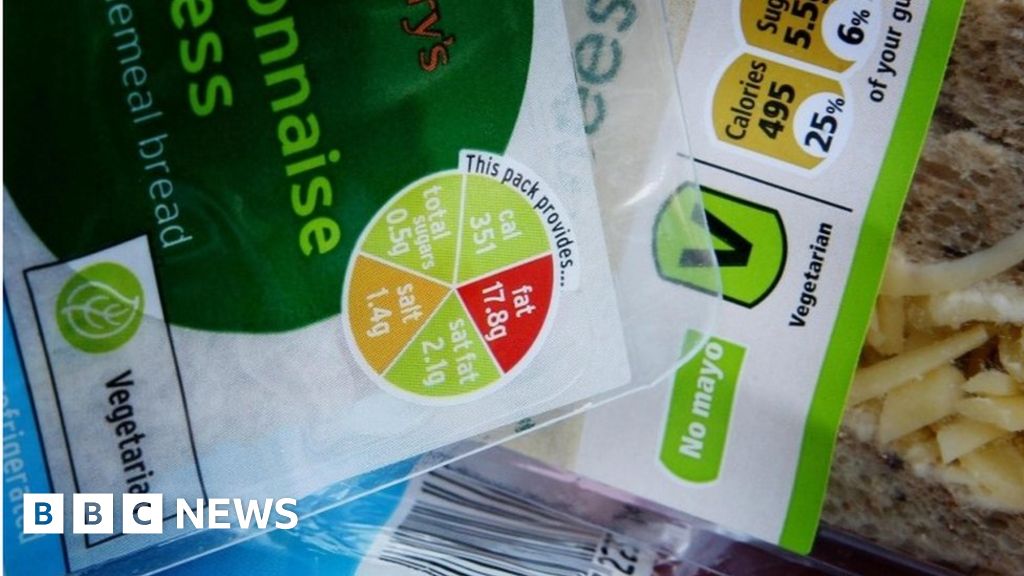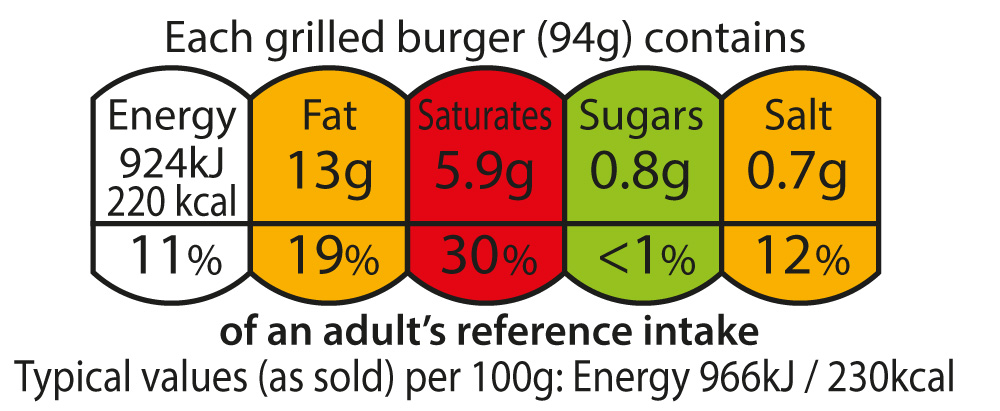42 food labels traffic light system
Is the food traffic light labelling system useful? | Patient The traffic light label was introduced in 2014, as part of an initiative by the government to improve public health. It was designed to give consumers an immediate idea as to whether something is: healthy (green or low) or not (red or high) in terms of fat, sugar or salt. Traffic light system Food labels: a critical assessment - PubMed An extra traffic light indicating the overall health value of the food should be added. A clearer BOP label also is needed. Implementation of a new food labeling system will probably be opposed by the food industry. More research is needed into which food label designs are most effective, especially for persuading consumers to select healthier ...
'Traffic light' food labels gain momentum across Europe Traffic light food labels were first introduced in the UK with the aim of providing consumers with a clearer indication about the amount of salt, sugar or fat contained in the products they buy....

Food labels traffic light system
Why food 'traffic-light' labels did not happen - BBC News One was guideline daily amounts (GDAs) and the other was a traffic-light system - a postage-stamp sized sticker that used a colour code to denote the percentage of a person's recommended daily... Looking Into Food Packaging Labels, The GDA And Traffic Light System The different levels of high to low are displayed via the traffic light system, green, amber and red. Green being the most ideal choice of the lowest intake and healthiest option, amber sitting in the middle being moderate and red meaning it's the highest intake. GDA system Traffic light system | Healthy Eating Advisory Service The Victorian Government's Healthy Choices guidelines use a 'trafflic light system' to categorise foods and drinks into three groups. Food and drink categories GREEN (Best choices) Foods and drinks in the GREEN category are the healthiest choices. They are usually: good sources of important nutrients lower in saturated fat, added sugar and/or salt
Food labels traffic light system. How 'traffic light' labels promote healthier eating "several small, experimental studies have suggested that 'traffic light' labels can be an effective method of promoting healthier choices, but there have been few real-world studies of customers' perceptions and purchasing behaviors in response to this type of labeling," explained lillian sonnenberg of mgh nutrition and food service, the … Traffic light labelling UK - How to apply to your food label It uses visual cues to summarise the nutrient profiles of products (sugar, carbohydrates, salt and fat) giving them a red, orange, green rating based on recommended daily intake levels. The greener the product, the healthier it is suggested to be. How to apply the traffic light labelling to your food label Traffic light diets label foods 'red,' 'yellow' and 'green.' That's too ... The traffic light diet and related food-labeling systems have gradually become more popular over the past several years, used in dieting apps, on food labels and in cafeterias. Even Google and the ... Traffic light labelling of meals to promote sustainable consumption and ... Traffic light labelling indicating carbon emission levels of food products has been used as a method of information provision to help increase consumer awareness around the subject, and to motivate behavioral change.
Traffic Light Food Labels Change the Way You Eat? - RecipeLand.com Traffic Light Labelling uses colour coding to inform consumers of the healthiness of the foods they are choosing. Foods low in fat, saturated fat, sugar and salt have green labels. Foods with yellow labels are neither high nor low in fat, saturated fat, sugar and salt. Foods that are high in fat, saturated fat, sugar and salt have red labels. The Traffic Light Food Labelling System - EHH Education The Traffic Light Food Labelling System For people who want to buy and consume healthy food without necessarily going through the long list of nutrition facts. Image credit:Instagram/ADPHC. What do we mean by that? The UAE recently introduced a simplified food labeling system to support people in making quick decisions. Traffic Light Food Labelling | Australian Medical Association The AMA believes it is time to improve food choices and tackle obesity with the introduction of a Traffic Light system of front-of-pack labelling. This AMA publication - Traffic Light Labelling: making healthy food choices easier for Australians - outlines the case for this important measure. Food Label Traffic Light System - Labelservice In 2008 The Food Standards Agency first requested for implementing traffic light labeling on food products. The idea was heavily objected and criticized by many retailers and manufacturers. But the new system announced by the Department of Health, mentions about the big red stickers that have to be placed on the food packets.
PDF Traffic-light food labels - Medical Journal of Australia Zimmet and James recommend "traffic-light" food labels (red, amber, green) as a way of educating shoppers in the nutritional qual-ity of foods.1 Traffic-light food labels2 pro-mote the moderation message, with moderation indicated by an amber colour. Shoppers can see at a glance a foods' profile of compliance with the guidelines for each of Do Individuals Use Nutrition Labels on Food Packages to Make Healthy ... Nutrition labels on food packages are designed to assist consumers in making healthy decisions. Based on the model of a dual-process system, the current study examined how people might be affected by nutrition labels and consuming contexts when making choices about healthy foods. Using four types of nutrition labels (i.e., the NuVal label, 5-Color nutrition label, traffic light label, and ... A Traffic Light System for Labeling Food? - QualityHealth The traffic light system uses colors to alert consumers at a glance about a food's nutrient content. One version uses a panel with green, amber and red dots to rate the salt, sugar, saturated fat and total fat in a food. Another version uses just a single colored dot to assign an overall rating to the food, rather than rating each nutrient. Traffic Light Labeling System - Consumer Voice Traffic Light Labeling System In 2007, Food Standard Agency of UK developed a method of labeling food with a traffic light showing how much fat, sugar and salt are in that food. High Content (unhealthy) is shown by red, Medium (moderate) by amber and Low (healthy) by Green colors. Food with Green color is preferred over the ones with red color.
Food and drink labels to show 'eco scores' traffic light system under ... June 27, 2021, 9:30 AM · 2 min read. An "eco score" label will be added to selected ranges of food and drink as part of the scheme (Foundation Earth) Environmental impact scores will appear ...

Traffic Light Food Labels Help Shoppers Make Healthier Choices | Food labels, Nutrition ...
Red, amber and green: UAE's new 'traffic light system' to label food is ... The traffic light food labeling system and the percentages system on the food label provide quick information on the adult's daily intake of each food item, helping to develop a healthy and...
Traffic-light system of 'eco-scores' to be piloted on British food labels A new traffic light system on food and drinks packaging is being launched to allow consumers to make more environmentally friendly choices. ... said that their labelling scheme was "based on a ...

Obesity and cancer – report highlights three things the Government could do - Cancer Research UK ...
Check the label | Food Standards Agency The traffic light labelling system will tell you whether a food has high, medium or low amounts of fat, saturated fat, sugars and salt. It will also tell you the number of calories and kilojoules...

Has anyone actually found a food product with 4 red traffic light label warnings on it? : AskUK
Food labels - NHS Most pre-packed foods have a nutrition label on the back or side of the packaging. These labels include information on energy in kilojoules (kJ) and kilocalories (kcal), usually referred to as calories. They also include information on fat, saturates (saturated fat), carbohydrate, sugars, protein and salt.
Food labelling: traffic light system vs activity equivalence The RSPH feels the current traffic light system is neither clear nor eye-catching enough to effectively communicate a product's calorific content, and instead wants to communicate how much exercise it would take to burn off the calories the product contains.
disadvantages of traffic light food labelling - Kazuyasu The traffic light system labels foods green, amber or red, to help consumers easily identify products that have low, medium or high levels of salt, fat and sugar. 10 The Agency has asked SACN to review and advice on intakes of sugars as part of its future work programme. Seasonâ s Greetings rather than Merry Christmas?
Traffic Light Food Label Stock Photos and Images - Alamy A person holds information brochures on colour-coded 'traffic light' nutrition labels for food packaging before a news conference in Berlin June 3, 2009. The frozen food producer Frosta is voluntarily introducing the label on four of its products, the company's head of marketing and distribution, Felix Ahlers, said on Wednesday.
Traffic Lights | food labelling | nutrition - Foodcounts The total food energy value, expressed as "calories", is the primary visual indicator, using a traffic-light scale to indicate the three relative bands of low, medium [mid] and high. The coloured calorie traffic-light is underpinned by white traffic-lights to display the three main macronutrients of fats, proteins, carbs, on the same high-low ...
Western Australia Schools Adopt Traffic Light Food Labeling System In 2007, Western Australia's Department of Education introduced the Healthy Food and Drink policy, which uses a traffic light system to indicate the nutritional value of various foods and determine whether or not they are permitted in school cafeterias. Progress to date: Survey data shows that the program has been positively received by the public.
Impact of front-of-pack 'traffic-light' nutrition labelling on consumer ... Abstract. Front-of-pack 'traffic-light' nutrition labelling has been widely proposed as a tool to improve public health nutrition. This study examined changes to consumer food purchases after the introduction of traffic-light labels with the aim of assessing the impact of the labels on the 'healthiness' of foods purchased.
Traffic light system | Healthy Eating Advisory Service The Victorian Government's Healthy Choices guidelines use a 'trafflic light system' to categorise foods and drinks into three groups. Food and drink categories GREEN (Best choices) Foods and drinks in the GREEN category are the healthiest choices. They are usually: good sources of important nutrients lower in saturated fat, added sugar and/or salt
Looking Into Food Packaging Labels, The GDA And Traffic Light System The different levels of high to low are displayed via the traffic light system, green, amber and red. Green being the most ideal choice of the lowest intake and healthiest option, amber sitting in the middle being moderate and red meaning it's the highest intake. GDA system
Why food 'traffic-light' labels did not happen - BBC News One was guideline daily amounts (GDAs) and the other was a traffic-light system - a postage-stamp sized sticker that used a colour code to denote the percentage of a person's recommended daily...









Post a Comment for "42 food labels traffic light system"